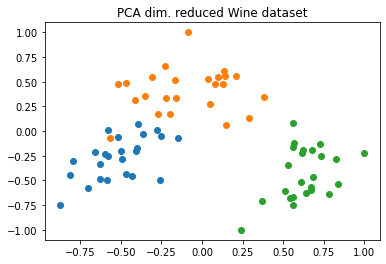Note
This page was generated from tutorials/machine_learning/02_qsvm_multiclass.ipynb.
Run interactively in the IBM Quantum lab.
QSVM multiclass classification¶
A multiclass extension works in conjunction with an underlying binary (two class) classifier to provide classification where the number of classes is greater than two.
Currently the following multiclass extensions are supported:
OneAgainstRest
AllPairs
ErrorCorrectingCode
These use different techniques to group the data from the binary classification to achieve the final multiclass classification.
[1]:
import numpy as np
from qiskit import BasicAer
from qiskit.circuit.library import ZZFeatureMap
from qiskit.aqua import QuantumInstance, aqua_globals
from qiskit.aqua.algorithms import QSVM
from qiskit.aqua.components.multiclass_extensions import AllPairs
from qiskit.aqua.utils.dataset_helper import get_feature_dimension
We want a dataset with more than two classes, so here we choose the Wine dataset that has 3 classes.
[2]:
from qiskit.ml.datasets import wine
n = 2 # dimension of each data point
sample_Total, training_input, test_input, class_labels = wine(training_size=24,
test_size=6, n=n, plot_data=True)
temp = [test_input[k] for k in test_input]
total_array = np.concatenate(temp)

To used a multiclass extension an instance thereof simply needs to be supplied, on the QSVM creation, using the multiclass_extension parameter. Although AllPairs() is used in the example below, the following multiclass extensions would also work:
OneAgainstRest()
ErrorCorrectingCode(code_size=5)
[3]:
aqua_globals.random_seed = 10598
backend = BasicAer.get_backend('qasm_simulator')
feature_map = ZZFeatureMap(feature_dimension=get_feature_dimension(training_input),
reps=2, entanglement='linear')
svm = QSVM(feature_map, training_input, test_input, total_array,
multiclass_extension=AllPairs())
quantum_instance = QuantumInstance(backend, shots=1024,
seed_simulator=aqua_globals.random_seed,
seed_transpiler=aqua_globals.random_seed)
result = svm.run(quantum_instance)
for k,v in result.items():
print(f'{k} : {v}')
testing_accuracy : 1.0
test_success_ratio : 1.0
predicted_labels : [0 1 2 2 2 2]
predicted_classes : ['A', 'B', 'C', 'C', 'C', 'C']
[4]:
import qiskit.tools.jupyter
%qiskit_version_table
%qiskit_copyright
Version Information
| Qiskit Software | Version |
|---|---|
| Qiskit | 0.24.1 |
| Terra | 0.16.4 |
| Aer | 0.7.6 |
| Ignis | 0.5.2 |
| Aqua | 0.8.2 |
| IBM Q Provider | 0.12.2 |
| System information | |
| Python | 3.7.7 (default, Apr 22 2020, 19:15:10) [GCC 9.3.0] |
| OS | Linux |
| CPUs | 32 |
| Memory (Gb) | 125.71903228759766 |
| Tue May 25 15:19:34 2021 EDT | |
This code is a part of Qiskit
© Copyright IBM 2017, 2021.
This code is licensed under the Apache License, Version 2.0. You may
obtain a copy of this license in the LICENSE.txt file in the root directory
of this source tree or at http://www.apache.org/licenses/LICENSE-2.0.
Any modifications or derivative works of this code must retain this
copyright notice, and modified files need to carry a notice indicating
that they have been altered from the originals.